Increasingly, cities worldwide focus more on bike paths, making it easier than ever to ride to work. Folding bikes are a great way to take advantage of this trend. They are light, easy to ride, and can be folded into a compact package.
Commuting on your folding bike is pretty straightforward. All you need is essential equipment, like a helmet and cycling sunglasses.
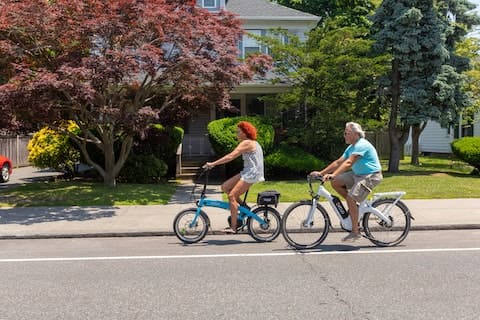
You’ll also need to know a few technical skills, like learning the correct posture. Read on to discover everything you need to know to commute on a folding bike comfortably.
Are Folding Bikes Good for Commuting?
Folding bikes are ideal for urban commuting due to their portability and space-saving design. Easily stored in offices or public transport, they address theft concerns and storage issues. Lightweight and adaptable, they enable seamless transitions between different travel modes, making them a flexible and eco-friendly commuting choice.
Here are a few reasons why folding bikes are ideal for commuting.
- Foldable bicycles are lightweight and easy to fold after you finish using them. You can even slot them into your locker or under your desk rather than leaving them outside where they can be stolen.
- Once folded, they can be taken onto buses or trains without restrictions. The London Underground, for example, permits taking folding bikes at all times without any restrictions.
- Riding a portable bike can help you save money, as you don’t need to pay for petrol or public transport. With some maintenance, these bikes should last for years, requiring minimal repairs.
- Folding bikes are great for exercise and riding to work each day will improve your health.
Choosing the Right Folding Bike for Commuting

There are dozens of folding bikes available. But not all of them are suited to commuting. To help you narrow down your folding bike options, here are some of the qualities an excellent commuter folding bike should possess:
- Easy to fold. Most folding bikes can go from folded to ready to ride within seconds.
- Compactness. One of the biggest appeals of a folding bike is the ability to fit it into a small space. The size of the wheels and the folding mechanism will affect the folded size. The product specifications will contain the bike dimensions when folded.
- Weight. Most folding bikes will be around 30 pounds, which allows you to carry them easily. A lightweight bicycle will also be easier to accelerate.
- Durability. It’s best to pay a little extra to purchase a bike from a reputable folding bike manufacturer, like Brompton or Tern. They will use high-quality parts to ensure their folding bicycles last for years. Furthermore, check the warranty policy to ensure you are covered for mechanical defects.
Consider how you will use your folding bike. For example, if you live in a hilly area, you might be better off getting a bike with at least a 7-speed drivetrain.
Best Folding Bikes for Commuting
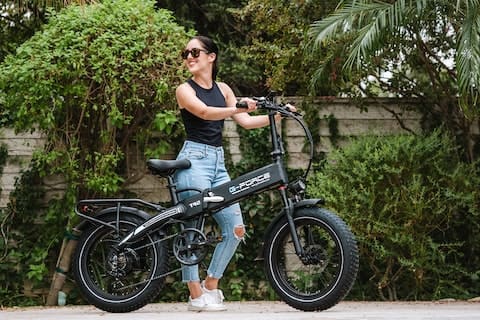
There are plenty of folding bikes that fulfill these requirements. Some of the most prominent options are:
- Brompton C Line. This is one of the most popular folding bike options. It is known for providing an exceptionally smooth riding experience while remaining compact enough to fit into a suitcase.
- Tern BYB S11. This bike comes with 20-inch wheels, which is rare for folding bikes. Because of this, you will get a smoother ride, even if there are bumps in the road.
- Tern Vektron S10. This might be a good option if you have a longer ride to work. It has 20-inch wheels and a 10-speed drivetrain, so you don’t have to worry about hills. There is also an electric motor, which you can rely on when tired. But this comes with a substantial downside: it weighs 45 pounds.
- Aventon Sinch. Most folding bikes aren’t designed to go over rough road patches. However, the Aventon Sinch has a four-inch-wide tire, which will help you cope with uneven ground. It also comes with a motor to make climbing hills easy. But this comes at a price. It is on the heavier end of the scale, weighing 66 pounds.
Over recent years the number of folding bikes available has exploded. Because of this, you should be able to find one that will suit your needs.
Is Brompton a Good Commuter Bike?
Brompton bicycles are renowned for their patented foldable design, making them especially suited for urban commuting. Brompton uses a 16-inch wheel size which results in a compact size when folded allowing for easy transport on trains, buses, or in car trunks. Built for city navigation, they offer quick adjustments and a sturdy ride, all while being lightweight.
Pros and Cons of Commuting on a Folding Bike
Taking a folding bike to work isn’t going to suit everyone. To help you decide if this is the right option, let’s look at the advantages and drawbacks of this approach.
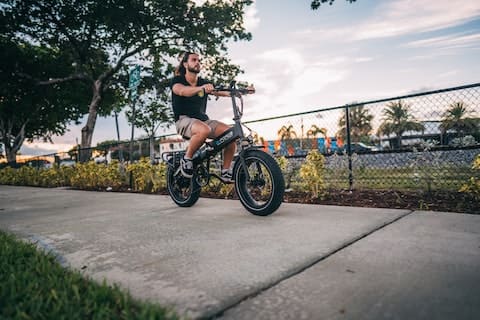
Benefits of Commuting on a Folding Bike
There are dozens of reasons why people choose to commute on a folding bike; these include:
- Saving money. You can save money on petrol by cycling to work each day. Over a year, this can be a substantial saving. It’s estimated that the average American spends between $2,000 to $5,000 on transport costs each year.
- Convenience. Increasingly, governments are focusing on building more bike paths, making it easier to get around the city. Plus, you won’t need to waste your time sitting in traffic.
- Comfortable to ride. These bikes are easy to ride. You can ride in your office wear if you are only going a short distance.
- It can fit on public transport. If the weather turns against you, or you want a break from riding, you can fold the bike and hop onto public transport.
- Keeps you fit. Doctors recommend that you get at least 150 minutes of exercise per week. Riding a bike to work is an excellent way of incorporating fitness into your daily routine. The NCOA advises that staying active in cold weather is equally important, again this is something that can be achieved on a folding bike provided you are appropriately dressed for winter riding.
Drawbacks of Commuting on a Folding Bike
The most significant negatives associated with commuting on a folding bike are:
- Need help dealing with bumpy roads. Due to their smaller, thinner wheels, folding bikes can run into problems on roads with many potholes. In most cases, you should be able to steer away from these problem areas. But if this is a substantial problem, you can find models with wider wheels and a more advanced suspension system.
- Storing the bike. Folding bikes are known for being compact. But space is at a premium for crowded workplaces or small apartments. If this applies to you, check the folded size to better understand how compact the bike will be.
- Security. An excellent folding bike will start at around $400, but you can easily spend over $4,000. So, it’s vital to protect your investment, placing it in an area that won’t attract thieves.
Preparing For Commuting on a Folding Bike
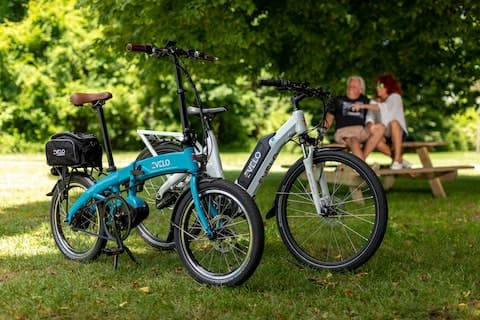
It can be intimidating to start commuting on your folding bike. But, with some preparation, you can ensure that everything goes smoothly. Here are some things to do:
Plan The Route
The best way to place to start is by planning your route. Ideally, you can use bike paths or stick to quieter streets until you build the confidence to travel on busy roads.
It’s also important to consider the quality of the streets. Avoid anything with large potholes, bumps, or gravel, as the small folding bike wheels will struggle over this terrain.
Next, it’s essential to consider the length. If you face a long commute, you might only want to travel part of the way on your bike. The rest of the journey can be on public transport. Over time, you can build up your physical endurance for a longer ride.
Leave Early
As you get used to riding to work, it’s best to start leaving 10 minutes early. This ensures you can commute at your own speed rather than worrying about being late for work.
What To Do During Poor Weather
Sadly, we can’t always have sunny days. Here are some ideas on what you can do during a rainy day:
- Use public transport. This is one of the most popular options. The bike is small enough to fit onto a bus or train when folded. To avoid disturbing other passengers, you can slide it under your chair.
- Drive to work. Most folding bikes should fit in the boot if you want to carpool home with a friend.
- Ride in the rain. There are a few precautions to take when riding in inclement weather. First, wearing a raincoat and placing valuables in a waterproof bag is a good idea. Most folding bikes will allow you to install fenders to protect you from the mud. At the end of the day, remove any dirt from your chain.
Preparing For A Flat Tire
A flat tire is a common issue faced by cyclists, although less so on folding bikes which tend to have reinforced kevlar tires.
Thankfully, there are puncture kits you can get to patch it up until you can get home and change the tire. It would help if you also took a pump with you. This gear can sit in your backpack. Place the kit in your pannier bag.
Maintaining Your Bike
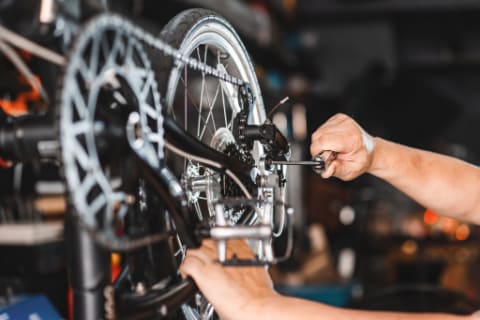
If you take care of your folding bike, it should last many years. Here are four things you’ll need to do to keep your bike in excellent condition:
- Clean the bike. This is especially important after riding on a wet day with mud clinging to the frame. Most of the time, you’ll need hot water and soap to clean the bike.
- Degrease the drive train. This is best to use on areas like the cassette, chain, and crankset.
- Lubricate the chain. Doing this can extend the chain’s life while stopping it from creaking as you ride.
- Check the tire pressure. The correct pressure is printed on the side of the tire.
Maximizing Convenience and Comfort in Folding Bike Commuting
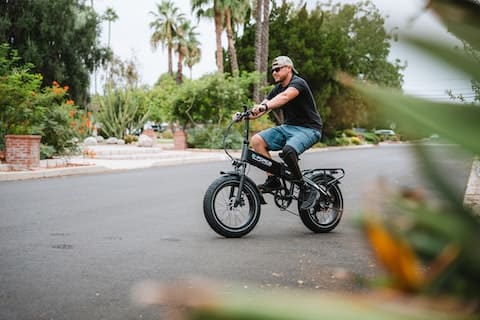
Commuting to work should be a comfortable experience. Here are my tips to help you get the most out of your commute.
Finding The Right Riding Posture
Without the correct posture, you will be placing a lot of pressure on your joints, which can often lead to back pain at the end of the ride:
- Check the standover height. You should aim for a few centimeters of clearance between your bottom and the saddle.
- Adjusting the saddle height. Your knee should be slightly bent when you are at the bottom of the pedal stroke to ensure you are getting the maximum power output. You should adjust your saddle height to achieve this (my tip is to place your heel on the pedal at the bottom of the stroke, at which point your knee should be locked out and then fine-tune from there).
- Relax your shoulders and bend your elbows. Have some flexibility in your elbows rather than locking them into place. This will help you get over any rough patches on the road. Plus, this will take the pressure away from your shoulders, so you won’t have neck pain at the end of your ride.
- Keep your core engaged. This will stop your spine from curving outwards during your ride, which will cause back pain.
There is no perfect riding posture. You’ll often need to experiment a little to find a position that feels comfortable for you.
What Gear To Take On Your Ride
Here are some pieces of gear that will make the daily commute more comfortable:
- Padded bike pants. Most of the time, folding bikes only have a little padding in their seats. Wearing padded bike pants will stop your buttocks from aching after a long ride.
- Clipless pedals. These will allow you to put a lot of power behind each stroke, so you can build up speed quickly.
- Cycling sunglasses. As you ride, these will keep the bugs and wind out of your eyes.
Staying Hydrated
Dehydration is a significant risk for cyclists, particularly during the summer months. Thankfully, there are a few ways that you can stay hydrated when riding. First, you can use a CamelBak. This is a backpack with a water bladder and a flexible pipe straw. Alternatively, you can place a water bottle under your bike. The cage holder might be extra for some types of folding bikes.
Consider using electrolytes, especially when you are getting used to commuting to work. This can help reduce the number of cramps you experience.
Staying Safe While Commuting on a Folding Bike
It’s common to be concerned about the safety of riding a folding bike, particularly if this is your first time riding on the road. But, as long as you keep a few basic safety rules in mind, you shouldn’t have any issues.
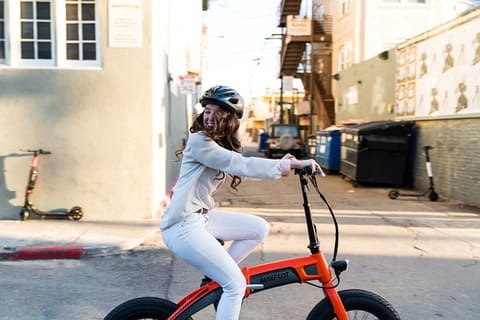
Remain Visible
Other road users must be able to see you coming. Here are some ways to improve your visibility:
- Wear fluorescent clothing during the day
- Choose reflective clothing at night. In particular, add ankle and knee reflectors. These move as you ride which helps 94 percent of drivers recognize a cyclist.
- Have a front and rear light, particularly when traveling at night.
Get The Right Safety Equipment
You should always wear the following safety equipment when you are riding your bike:
- Helmet. This will protect you from head trauma during an accident. Before your ride, check that the helmet is fitted correctly. You shouldn’t be able to shake it from side to side. Too far forward, and it will block your vision. If it’s too far back, your forehead will be exposed in an accident.
- Sunglasses. These keep the sunlight out of your eyes and protect you from the wind.
- Breathable clothes. These will prevent you from overheating and ensure a more pleasant ride.
Learning How To Ride In Traffic
Riding in traffic is one of the most nerve-wracking experiences, particularly if you are new to commuting. Here are some tips for mastering this skill:
- Watch your surroundings. Pay attention to the other traffic and know where you are positioned in relation to other drivers. You should also scan the road ahead for potential hazards, like potholes.
- Think about your position. When it’s unsafe for other drivers to overtake, or you want to let them know you are on the road, you can move into the primary position in the middle of the left-hand lane. When it is safe for a vehicle to overtake, move to the second position on the left of the road.
- Avoid the gutter. Stay at least 1m away from the drain. This ensures you don’t need to worry about swerving out of the way when a driver opens their door.
Commuting On A Folding Bike: My Verdict
Getting used to commuting with a folding bike can take a few weeks. But once you settle into a routine, you will grow more comfortable riding the bike on busy roads. Most importantly, you’ll be able to relax and enjoy the journey.

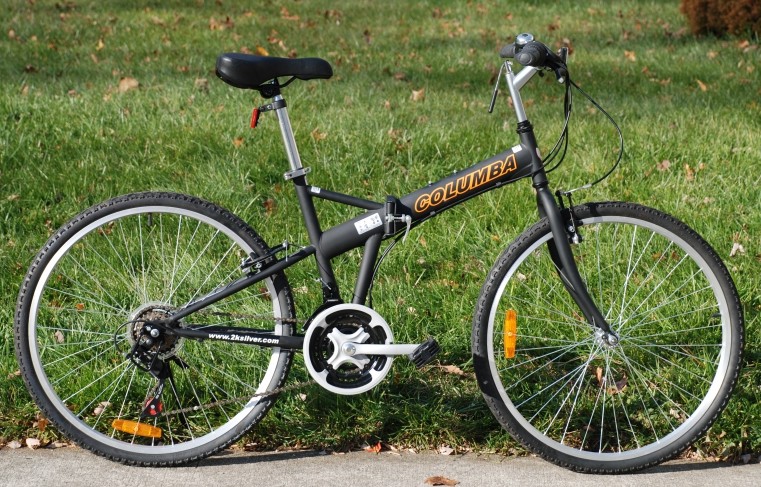
![Durban Folding Bike Review [year] – 5 Reasons NOT to Buy](https://www.foldingbikeguy.com/wp-content/uploads/2015/09/Durban-One-Review-e1596765769750.jpg)
![7 Best Bike Racks for Honda Accord [Year]: Rated by Experts](https://www.foldingbikeguy.com/wp-content/uploads/Best-Bike-Rack-for-Honda-Accord-768x473.jpg)
![Hummingbird Bike Review [year]: Is This Folding Bike Worth It?](https://www.foldingbikeguy.com/wp-content/uploads/2020/08/Hummingbird-Folding-Bike-Review-768x512.jpg)
![What is the Smallest Folding Bike? 6 Most Compact Bikes [Year]](https://www.foldingbikeguy.com/wp-content/uploads/What-is-the-Smallest-Folding-Bike.jpg)